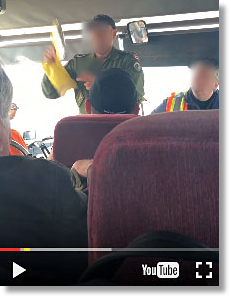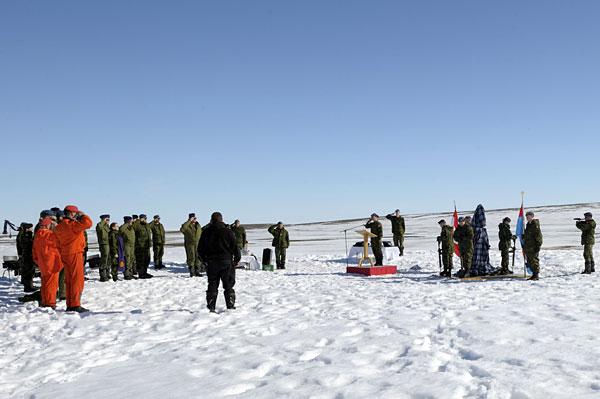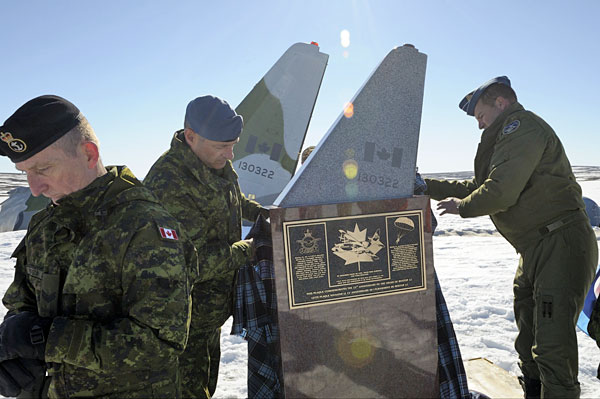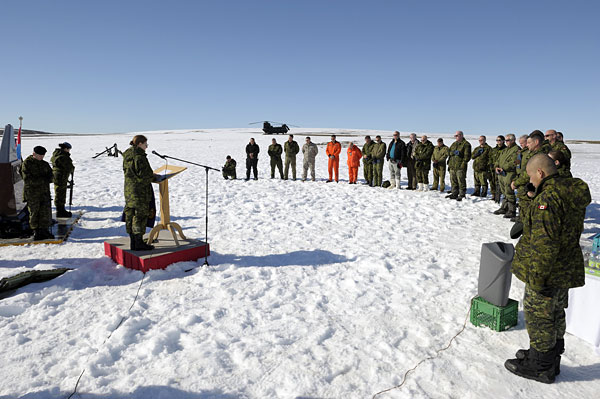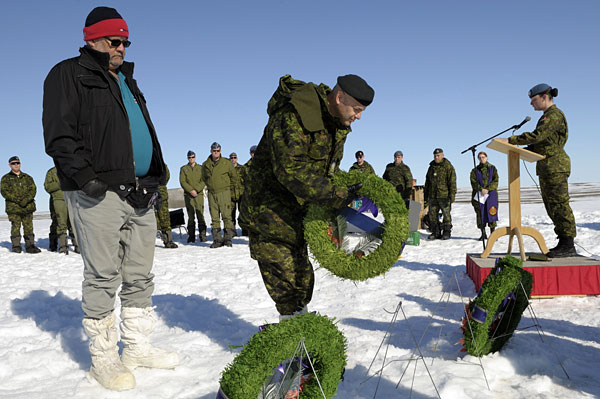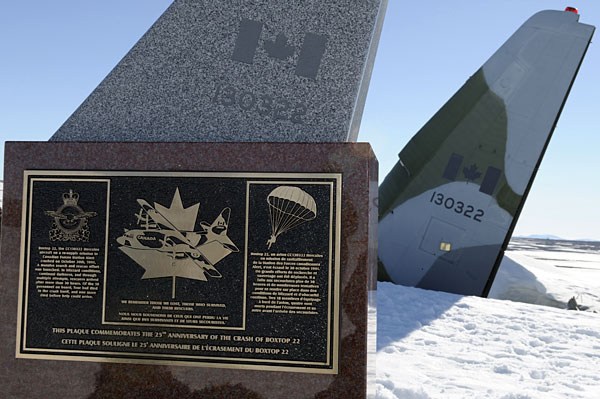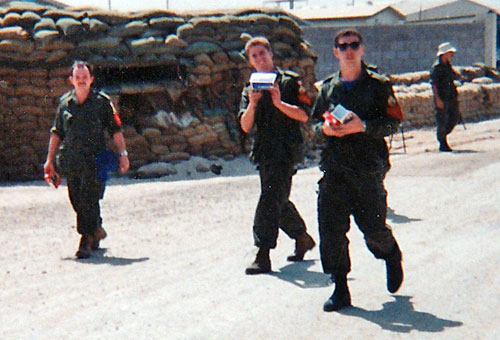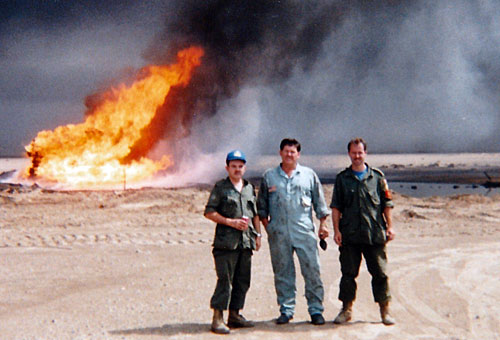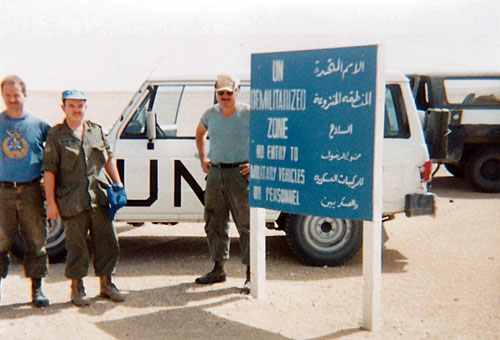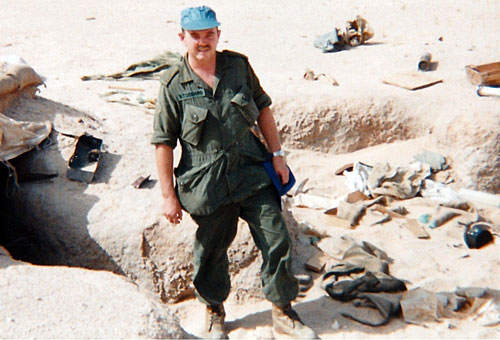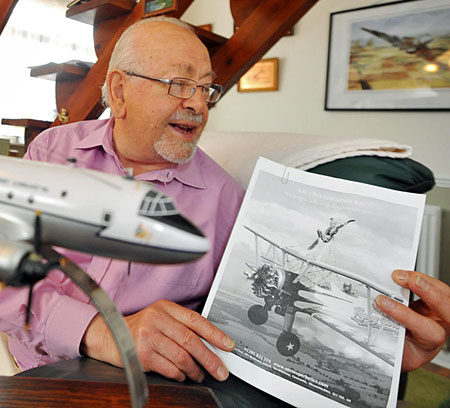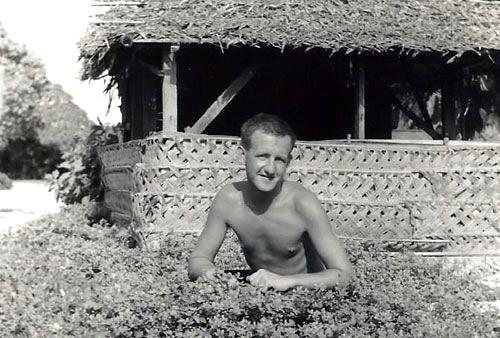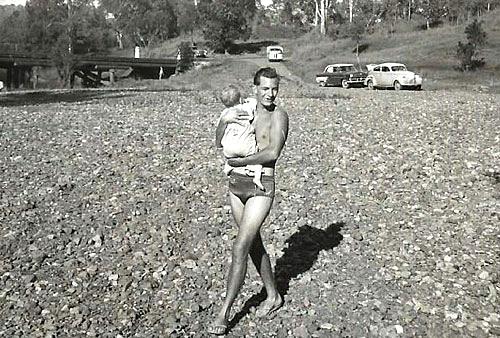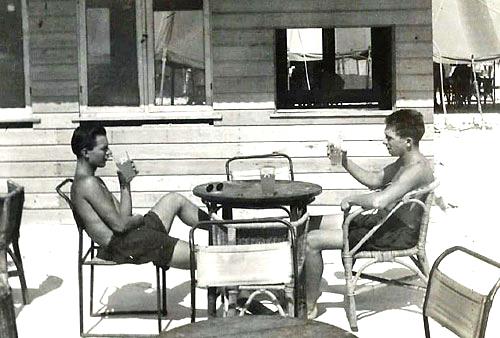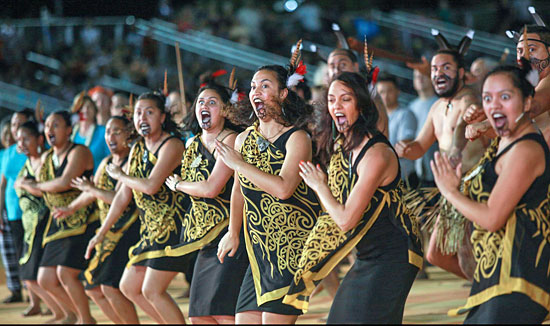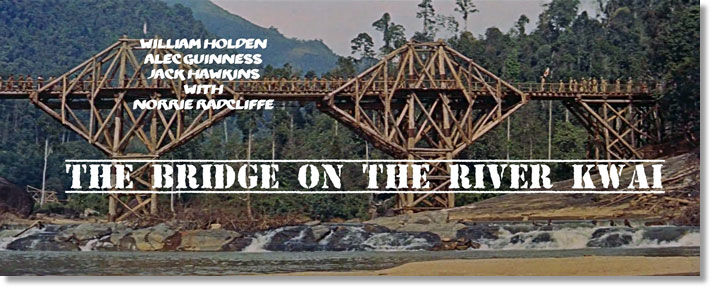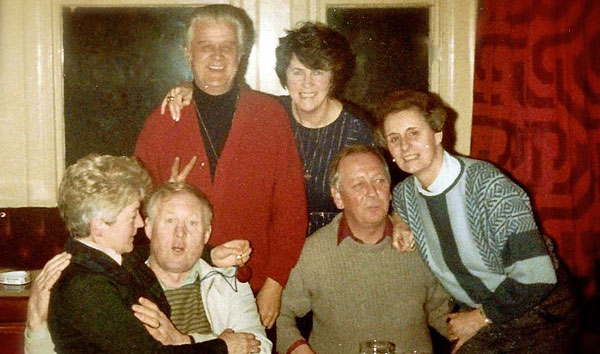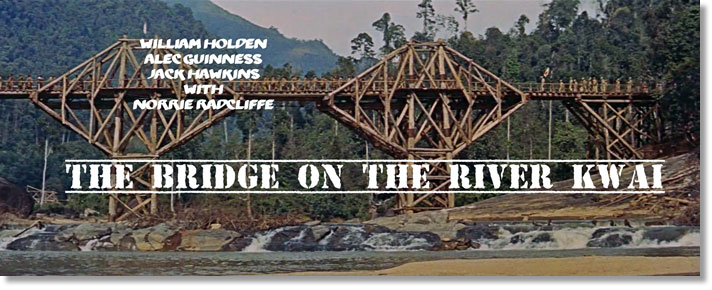From: David Powell, Princes Risborough
Subject: Assume The Position Continued
Hi Tony,
Thank you for another entertaining, interesting newsletter and, with the news that UKMAMS is back, heart lifting joy. Indeed an excuse to pour a wee malt, face west down the A40 and drink to the continued health of the reborn teams!
Anyway - reason for writing was Graham Allen's story about batting at Gatwick. I may have told this before but I was reminded of an incident that happened during my JFK detachment mentioned in the last issue.
It was a Sunday afternoon in the summer of '66, and we had a freighter Belfast in for a night stop; empty, probably on its way to pick up priority Phantom spares. I had gone up to JFK more as a courtesy and something to do as there were no loads or pax on or off. The civil contractors, Allied, would handle all aspects of the turn-round and crew handling etc. Being an off-duty Sunday, wearing just jeans and t-shirt, I wandered out onto the ramp, with not a viz vest, ear-defender or hard hat in sight (those were the days!) to join my Allied reception team friends sitting on some vertical sloping sound deflectors, opposite the allotted stand 42, enjoying the afternoon sun and watching the activity.
In due course and on time, the Belfast was spotted in the landing stream. It then disappeared out of sight beyond the terminal buildings.
Five minutes passed; no sign of our aircraft; 10 minutes and still no sign. Belfast lost. This happened sometimes, as JFK was big with no friendly 'Follow Me' Landrovers to guide. If you came to JFK, you are expected to read a map of the airport and its taxiways.
Subject: Assume The Position Continued
Hi Tony,
Thank you for another entertaining, interesting newsletter and, with the news that UKMAMS is back, heart lifting joy. Indeed an excuse to pour a wee malt, face west down the A40 and drink to the continued health of the reborn teams!
Anyway - reason for writing was Graham Allen's story about batting at Gatwick. I may have told this before but I was reminded of an incident that happened during my JFK detachment mentioned in the last issue.
It was a Sunday afternoon in the summer of '66, and we had a freighter Belfast in for a night stop; empty, probably on its way to pick up priority Phantom spares. I had gone up to JFK more as a courtesy and something to do as there were no loads or pax on or off. The civil contractors, Allied, would handle all aspects of the turn-round and crew handling etc. Being an off-duty Sunday, wearing just jeans and t-shirt, I wandered out onto the ramp, with not a viz vest, ear-defender or hard hat in sight (those were the days!) to join my Allied reception team friends sitting on some vertical sloping sound deflectors, opposite the allotted stand 42, enjoying the afternoon sun and watching the activity.
In due course and on time, the Belfast was spotted in the landing stream. It then disappeared out of sight beyond the terminal buildings.
Five minutes passed; no sign of our aircraft; 10 minutes and still no sign. Belfast lost. This happened sometimes, as JFK was big with no friendly 'Follow Me' Landrovers to guide. If you came to JFK, you are expected to read a map of the airport and its taxiways.
The memorial cairn, designed by a team at 1 Canadian Air Division and the Engineering Section of Real Property Operation Detachment Trenton, was flown to CFS Alert and then slung via a CH-147 Chinook helicopter to the crash site in order to have the memorial dedicated at the sacred site. The 1,133-kilogram cairn, shaped like the tail of the Hercules where survivors huddled after the crash, will then be flown back to 8 Wing Trenton where it will be unveiled in the presence of family members of those who died, and survivors and rescuers, at a ceremony on or about October 30, 2016, the actual anniversary of the crash. The RCAF is contacting families and survivors as planning for this event builds momentum.
MWO Cobden admits that being at the site and taking part in the ceremony made him emotional for the first time. “We did lose some lives here,” he says, his voice wavering. “I'm just happy I got the opportunity to be invited back to see it in person, because it was dark then.”
Royal Canadian Air Force Public Affairs
MWO Cobden admits that being at the site and taking part in the ceremony made him emotional for the first time. “We did lose some lives here,” he says, his voice wavering. “I'm just happy I got the opportunity to be invited back to see it in person, because it was dark then.”
Royal Canadian Air Force Public Affairs


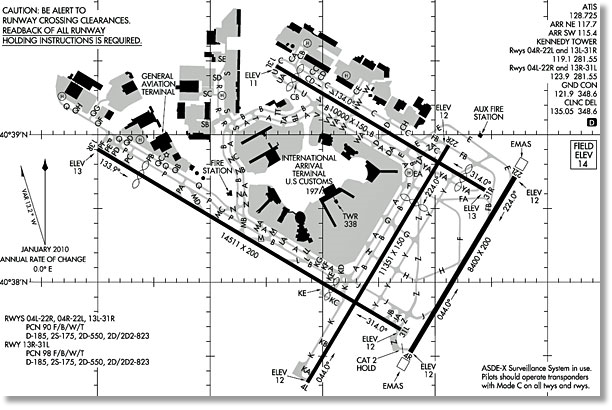
After about a quarter of an hour there came the familiar rumble of a Belfast - from completely the opposite direction to that which we were expecting. At least it was now heading towards the patch of tarmac labelled stand 42. However, instead of stopping, it just kept slowly trundling along.
What to do? I did what any young MAMS officer would do. I chased after my freighter across the ramp.
To a background of much cheering and whooping from the Allied spectators on the improvised bleachers. I managed to catch and overtake the Belfast, was spotted by the co-pilot and I managed a sort of running-backwards-raised-crossed-arms. On went the brakes to a sarcastic cheer from the bench. But I did get the last laugh. Seeing that the Belfast was lined up with its overshot stand, following some impromptu gesticulating, the Captain got the message. Reverse prop settings were selected, and I then marshalled the mighty machine backwards onto its allotted spot. A manoeuvre my spectators had never actually seen before or were even aware was possible!
Stay safe
David Powell
F Team UKMAMS Mk 1 1967-69
What to do? I did what any young MAMS officer would do. I chased after my freighter across the ramp.
To a background of much cheering and whooping from the Allied spectators on the improvised bleachers. I managed to catch and overtake the Belfast, was spotted by the co-pilot and I managed a sort of running-backwards-raised-crossed-arms. On went the brakes to a sarcastic cheer from the bench. But I did get the last laugh. Seeing that the Belfast was lined up with its overshot stand, following some impromptu gesticulating, the Captain got the message. Reverse prop settings were selected, and I then marshalled the mighty machine backwards onto its allotted spot. A manoeuvre my spectators had never actually seen before or were even aware was possible!
Stay safe
David Powell
F Team UKMAMS Mk 1 1967-69
From: Thomas Geoghegan, Folkestone, Kent
Subject: Re: UKMAMS OBA OBB #052716
Hello old chap,
Subject: Re: UKMAMS OBA OBB #052716
Hello old chap,
Going to put my pennyworth in again relating to your latest. Must say having served in a military and a civilian role for nigh-on fifty years in aviation, never have I experienced a before a flight briefing, by the RCAF Load Master with the vocabulary problem. Suggest the briefing was lacking and inadequate and should his superiors have witnessed the same, should take appropriate, taking all things into account.
Regarding the Assume the Position item; on my arrival at RAF Colerne, 49 Maintenance Unit, early 60's the first item on the agenda was an aircraft marshalling course. Remember the first time I did it for real, scared stiff of the huge HP Hastings bearing down on me, then trying to extract a great chock from in front of the huge main wheel on other occasions. I assumed we all had have the marshalling know how, came in handy a few times where I was involved and others were not available.
Best Regards,
Tod
Regarding the Assume the Position item; on my arrival at RAF Colerne, 49 Maintenance Unit, early 60's the first item on the agenda was an aircraft marshalling course. Remember the first time I did it for real, scared stiff of the huge HP Hastings bearing down on me, then trying to extract a great chock from in front of the huge main wheel on other occasions. I assumed we all had have the marshalling know how, came in handy a few times where I was involved and others were not available.
Best Regards,
Tod
(With regards to the pre-flight briefing… I can’t defend the Loadmaster, only he can do that for himself. I can however provide you with an insight into the circumstances and perhaps lessen your anguish. Picture a bunch of roughie-toughie oil rig workers who have been working their rotation in the oil sands and are suddenly thrust into a life threatening situation whereby they have to get out of there just as quickly as possible.
Along comes an RCAF C130 to rescue them. They are feeling very anxious and nervous - and one way that the Loadmaster can put them at their ease is through ribald humour, which of course they would not have expected coming from him. I’m fairly certain that none of the passengers was offended - quite the reverse - click on the picture above to see the briefing again on YouTube and read all the comments below it - Tony)
Going to put my pennyworth in again relating to your latest. Must say having served in a military and a civilian role for nigh-on fifty years in aviation, never have I experienced a before a flight briefing, by the RCAF Load Master with the vocabulary problem. Suggest the briefing was lacking and inadequate and should his superiors have witnessed the same, should take appropriate, taking all things into account.
Regarding the Assume the Position item; on my arrival at RAF Colerne, 49 Maintenance Unit, early 60's the first item on the agenda was an aircraft marshalling course. Remember the first time I did it for real, scared stiff of the huge HP Hastings bearing down on me, then trying to extract a great chock from in front of the huge main wheel on other occasions.
Regarding the Assume the Position item; on my arrival at RAF Colerne, 49 Maintenance Unit, early 60's the first item on the agenda was an aircraft marshalling course. Remember the first time I did it for real, scared stiff of the huge HP Hastings bearing down on me, then trying to extract a great chock from in front of the huge main wheel on other occasions.
I assumed we all had have the marshalling know how, came in handy a few times where I was involved and others were not available.
Best Regards,
Tod
Best Regards,
Tod
The 25th anniversary of the crash of Boxtop 22
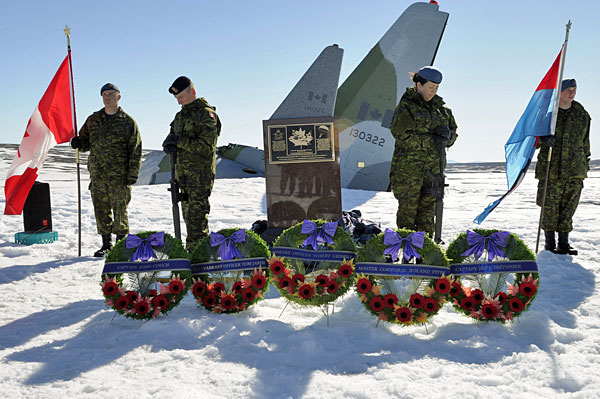
Corporal Brett Guitard (left), Leading Seaman Garnet Robinson, Corporal Yvette Cedeno and Aviator Alain Fortier serve as sentries at the memorial cairn during its dedication marking the 25th anniversary of the crash of Operation Boxtop Flight 22.
Under the hands of 8 Wing Commander Colonel Colin Keiver, a CC-130J Hercules aircraft circles an area 16 kilometres south of Canadian Forces Station Alert on June 14, 2016. Even on this beautiful sunny day, it is apparent this is no land to be messed with. Barren, snow-covered, and windswept - this is Canada’s most northern reaches. Add in darkness, blizzard conditions, and -30°C temperatures, and the feat of human survival becomes all that much more incredible.
“I can’t believe I spent more than 30 hours out here,” says Master Warrant Officer Tony Cobden as he looks out the small round window of the Hercules at the remnants of the CC-130 on the ground.
It was 25 years earlier when Master Warrant Officer Cobden, a communications researcher, and 17 others, were on board Boxtop Flight 22 when it crashed on final approach to CFS Alert during Operation Boxtop, the bi-annual resupply of the station. Logistics officer Captain Judy Trépanier, CANEX regional services manager Master Warrant Officer Tom Jardine, supply technician Warrant Officer Robert Grimsley and traffic technician Master Corporal Roland Pitre all died in the crash, while the aircraft’s commander, Captain John Couch, succumbed to hypothermia after leading the effort to survive in place, and giving up his coat to the other survivors.
“I can’t believe I spent more than 30 hours out here,” says Master Warrant Officer Tony Cobden as he looks out the small round window of the Hercules at the remnants of the CC-130 on the ground.
It was 25 years earlier when Master Warrant Officer Cobden, a communications researcher, and 17 others, were on board Boxtop Flight 22 when it crashed on final approach to CFS Alert during Operation Boxtop, the bi-annual resupply of the station. Logistics officer Captain Judy Trépanier, CANEX regional services manager Master Warrant Officer Tom Jardine, supply technician Warrant Officer Robert Grimsley and traffic technician Master Corporal Roland Pitre all died in the crash, while the aircraft’s commander, Captain John Couch, succumbed to hypothermia after leading the effort to survive in place, and giving up his coat to the other survivors.
Master Warrant Officer Cobden, the one survivor still serving today in the Canadian Armed Forces, fittingly represents all those on Boxtop Flight 22 during what is preparatory work ahead of 25th Anniversary commemorations to be held more accessibly in Trenton, Ontario, later this year. He is joined on this trip by fellow survivor Master Seaman (Ret’d) D.N. “Monty” Montgomery; search and rescue technician Sergeant Ben House, a member of the rescue team that parachuted into the crash site; and Lieutenant-Colonel (Ret’d) Scott McLean, the commanding officer of CFS Alert in 1991 who led the Station's response to the crash, dispatching overland rescue crews, supporting the SAR response, and preparing for and receiving the dead and wounded.
It’s their first trip to the site since the crash.
Monty, who still lives with the physical effects of the crash, lost all his fingers and half his toes to frostbite, then endured 12 gruelling surgeries to graft some toes to his hand to restore some dexterity. “I can put my foot in my mouth faster than anyone!” he quips. “I don’t like to use the word ‘closure’ because it’s been 25 years,” he adds on a more serious note. “It’s hard, it’s difficult; but I can say, this sort of closes it for me.”
Led by Royal Canadian Air Force commander Lieutenant-General Mike Hood and RCAF Chief Warrant Officer Gerry Poitras, the contingent also includes 8 Wing, CFS Alert, CFS Leitrim and 435 Squadron personnel, and members of the search and rescue leadership.
“It’s a very personal thing for me, and I felt strongly about wanting to go there,” says Lieutenant-General Hood, who knew and worked with some of the members who died. “We’re going to honour the memory of some fantastic Canadians.”
It’s their first trip to the site since the crash.
Monty, who still lives with the physical effects of the crash, lost all his fingers and half his toes to frostbite, then endured 12 gruelling surgeries to graft some toes to his hand to restore some dexterity. “I can put my foot in my mouth faster than anyone!” he quips. “I don’t like to use the word ‘closure’ because it’s been 25 years,” he adds on a more serious note. “It’s hard, it’s difficult; but I can say, this sort of closes it for me.”
Led by Royal Canadian Air Force commander Lieutenant-General Mike Hood and RCAF Chief Warrant Officer Gerry Poitras, the contingent also includes 8 Wing, CFS Alert, CFS Leitrim and 435 Squadron personnel, and members of the search and rescue leadership.
“It’s a very personal thing for me, and I felt strongly about wanting to go there,” says Lieutenant-General Hood, who knew and worked with some of the members who died. “We’re going to honour the memory of some fantastic Canadians.”
From: Basil H J Hughes, Pattaya
Subject: Memories
Dear Tony,
I am celebrating my 80th Birthday today and decided to do something I had been meaning to do for some time.
How many of us that served with the MAMS Section at RAF Abingdon are still with us?
30th October 1957 - I was called-up the day I completed my apprenticeship as a Shipwright for the MOD at Devonport and was assured that if I signed on for 3 years I would be accepted as Air Frame - lying recruiting Sgt!
First induction at Cardington and then on to Bridgenorth for basic training - It was cold - snow - and our Sgt had recently been, if one went by his uniform blouse, reduced from Ft Sgt. The rumour was that he had been chasing an attractive young lady across several back gardens in his car when he was drunk and he had been banned from driving. He actually confirmed this at our passing-out party as we carried him back to the camp.
January/February 1958 - Kidbrooke - Clerk Air Movements course - I am severely dyslectic but I had no problem and enjoyed the math.
1958 Spring - RAF Wildenrath where I was working on Weight and Balance sheets in the Load Control Office - Hastings, Valletta, Varsity, Pembroke and Anson. In the summer the Sqn Ldr came down to our billet one evening - there was a requirement for 6 movements personnel to be detached to the Middle East - he wanted volunteers - unmarried, both parents living and medically fit. There were no volunteers but only 6 of us fitted the requirements. We were immediately taken to sick quarters for jabs - both arms and backside. Then back to the billet to pack. We left Wildenrath at 6 am by 3-tonner into Holland to catch a train to the Hook, then ferry to Harwich - a train to London then another to 5 PDU Innsworth. The only food we had during the entire journey was sandwiches and we had to wait until breakfast time at 5 PDU before we had a hot meal. That day we were issued with tropical clothing and a passport valid for six months which could be extended on production of our birth certificate.
Subject: Memories
Dear Tony,
I am celebrating my 80th Birthday today and decided to do something I had been meaning to do for some time.
How many of us that served with the MAMS Section at RAF Abingdon are still with us?
30th October 1957 - I was called-up the day I completed my apprenticeship as a Shipwright for the MOD at Devonport and was assured that if I signed on for 3 years I would be accepted as Air Frame - lying recruiting Sgt!
First induction at Cardington and then on to Bridgenorth for basic training - It was cold - snow - and our Sgt had recently been, if one went by his uniform blouse, reduced from Ft Sgt. The rumour was that he had been chasing an attractive young lady across several back gardens in his car when he was drunk and he had been banned from driving. He actually confirmed this at our passing-out party as we carried him back to the camp.
January/February 1958 - Kidbrooke - Clerk Air Movements course - I am severely dyslectic but I had no problem and enjoyed the math.
1958 Spring - RAF Wildenrath where I was working on Weight and Balance sheets in the Load Control Office - Hastings, Valletta, Varsity, Pembroke and Anson. In the summer the Sqn Ldr came down to our billet one evening - there was a requirement for 6 movements personnel to be detached to the Middle East - he wanted volunteers - unmarried, both parents living and medically fit. There were no volunteers but only 6 of us fitted the requirements. We were immediately taken to sick quarters for jabs - both arms and backside. Then back to the billet to pack. We left Wildenrath at 6 am by 3-tonner into Holland to catch a train to the Hook, then ferry to Harwich - a train to London then another to 5 PDU Innsworth. The only food we had during the entire journey was sandwiches and we had to wait until breakfast time at 5 PDU before we had a hot meal. That day we were issued with tropical clothing and a passport valid for six months which could be extended on production of our birth certificate.
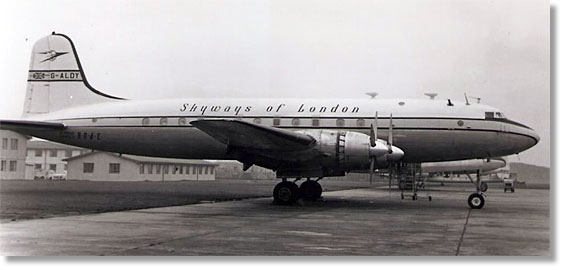
The next morning we set out for RAF Dunsfold in Surrey. We would be travelling to Aden in a chartered Skyways Hermes aircraft and we had to wear civvies. We were not exactly what you describe as smartly dressed. The route had to avoid Egypt and so we had a fuel stop at Luqa in Malta and brief stops at Kano in Nigeria and Entebee in Uganda. Tired and very weary we reached Khormaksar and transit accommodation only to be told that two of would be heading for Masirah and two for Sharjah - I was the oldest so would be going to Sharjah by Beverley the next morning taking off at 6am.
Sharjah in those days was all sand with jeeps towing railway lines down the runway every morning and the occasional camel train halting flying by crossing the runway. It appears an ancient camel track crossed the runway and they could not be diverted off that track.
Sharjah in those days was all sand with jeeps towing railway lines down the runway every morning and the occasional camel train halting flying by crossing the runway. It appears an ancient camel track crossed the runway and they could not be diverted off that track.
We were all issued with two litres of water a day - it came with a film of oil on the top and sand at the bottom. I was working nights at the port of Dubai which was just a very small port then with many Arab dhows. A ship was anchored off shore and was offloading bombs which were brought ashore on the dhows and then offloaded from the dhows with a hand crane, then using the same hand crane loaded seven at a time on to 3 ton lorries. I did not want to know how they got them off at the bomb dump as some of them looked very old.
Everyone on the camp had dysentery but were on active service and had to continue working taking mist morphine and Kaolin. Eventually in December the two of us, plus others, were pulled out and sent up to Bahrain for onward travel back to UK. At Bahrain the M.O. had a look at us and said we were unfit to travel so we had to stay for two weeks taking pills and potions before we could travel. We arrived at Lyneham and then we had to report to 5 PDU Innsworth. The M.O. there sent us on 2 weeks sick leave with orders to report back to RAF Wildenrath by January 1st. There the Sqdn Ldr had us sent to Sick Quarters (with the comment that were thinner than some of those that had been released from Changi Japanese POW camp.) He also told me that I had been promoted to SAC. (My GSM had LAC on it although I had never been told I had been promoted to that). Again on the advice of the M.O. we were sent on leave for six weeks as being in the M.O.s opinion unfit for duty. On my return I was told that I had been promoted to Local Acting Cpl and was being detached to RTO Hamburg as Cpl in charge (there was three airmen and a visit once a week, pay day, from a Flt Lt from Jever). I was also to assist with the payloads for the transport aircraft being used on the squadron exercise moves from RAF Jever and Sylt.
Everyone on the camp had dysentery but were on active service and had to continue working taking mist morphine and Kaolin. Eventually in December the two of us, plus others, were pulled out and sent up to Bahrain for onward travel back to UK. At Bahrain the M.O. had a look at us and said we were unfit to travel so we had to stay for two weeks taking pills and potions before we could travel. We arrived at Lyneham and then we had to report to 5 PDU Innsworth. The M.O. there sent us on 2 weeks sick leave with orders to report back to RAF Wildenrath by January 1st. There the Sqdn Ldr had us sent to Sick Quarters (with the comment that were thinner than some of those that had been released from Changi Japanese POW camp.) He also told me that I had been promoted to SAC. (My GSM had LAC on it although I had never been told I had been promoted to that). Again on the advice of the M.O. we were sent on leave for six weeks as being in the M.O.s opinion unfit for duty. On my return I was told that I had been promoted to Local Acting Cpl and was being detached to RTO Hamburg as Cpl in charge (there was three airmen and a visit once a week, pay day, from a Flt Lt from Jever). I was also to assist with the payloads for the transport aircraft being used on the squadron exercise moves from RAF Jever and Sylt.
1960 - I was very sorry to leave Hamburg - after living in the hotel which was only two minutes walk from the Reeperbahn. I was posted to RAF Stafford but first I had to report to RAF Kidbrooke for a Surface Movements course. At Stafford I was Cpl i/c the railhead with a squad of men offloading and loading railway trucks. The squad consisted mostly of AC2s who had failed every course they had been sent on and were "Airmen under Punishment." Some of them had to be watched really closely as the previous Cpl had be hospitalized as he had “accidentally” come into contact with a piece of timber being moved by one of those under punishment and fallen off the ramp onto the rails. While I was there I was sent on an explosives course.
1962 - RAF Christmas Island - Yes I can say I spent Christmas on Christmas Island and also flew round the world - it took a year mind you.
Late 1963 - Posted to RAF Abingdon MAMS Section. I was there in 1966 when it became a squadron and got married just 15 days later after a very boozy party of the whole squadron at a pub in Abingdon. Soon afterwards I was promoted to Sgt and transferred to ATDU (Air Transport Development Unit) RAF Abingdon.
1967 - Posted to Air Cargo Section RAF Changi - I was in the process of signing on for 22 when my wife had problems with the RAF which included her reporting a senior Medical officer being drunk. My ex-wife was a senior sister at a large hospital and any Doctor who was under the influence while on duty at that hospital was severely disciplined. As my ex-wife couldn't get any satisfaction from RAF Changi she sent a complaint to the Medical Council, and I finished up at RAF Colerne for my last few months.
Unfortunately, some years later I commented how much I missed the RAF and the comradeship - when I came home from work that day my RAF log book, Certificate of Service, Commendation from the AOC-in-C for work at RAF Stafford and photo albums had all been burned and my GSM vanished into thin air.
Cheers to all and thank you for the articles you submit and to Tony for all your hard work.
Basil
Sgt Basil H J Hughes (Retd), Supp 1, Q Air Mov, Q Surface Mov, Q Exp, Q Ocean Terminal Refueling.
1962 - RAF Christmas Island - Yes I can say I spent Christmas on Christmas Island and also flew round the world - it took a year mind you.
Late 1963 - Posted to RAF Abingdon MAMS Section. I was there in 1966 when it became a squadron and got married just 15 days later after a very boozy party of the whole squadron at a pub in Abingdon. Soon afterwards I was promoted to Sgt and transferred to ATDU (Air Transport Development Unit) RAF Abingdon.
1967 - Posted to Air Cargo Section RAF Changi - I was in the process of signing on for 22 when my wife had problems with the RAF which included her reporting a senior Medical officer being drunk. My ex-wife was a senior sister at a large hospital and any Doctor who was under the influence while on duty at that hospital was severely disciplined. As my ex-wife couldn't get any satisfaction from RAF Changi she sent a complaint to the Medical Council, and I finished up at RAF Colerne for my last few months.
Unfortunately, some years later I commented how much I missed the RAF and the comradeship - when I came home from work that day my RAF log book, Certificate of Service, Commendation from the AOC-in-C for work at RAF Stafford and photo albums had all been burned and my GSM vanished into thin air.
Cheers to all and thank you for the articles you submit and to Tony for all your hard work.
Basil
Sgt Basil H J Hughes (Retd), Supp 1, Q Air Mov, Q Surface Mov, Q Exp, Q Ocean Terminal Refueling.
Her Majesty the Queen's 90th Birthday Flypast 11 June 2016
Queen's Birthday Flypast: Introducing the Hercules
Queen's Birthday Flypast: Introducing the Puma
Queen's Birthday Flypast: Introducing the Chinook
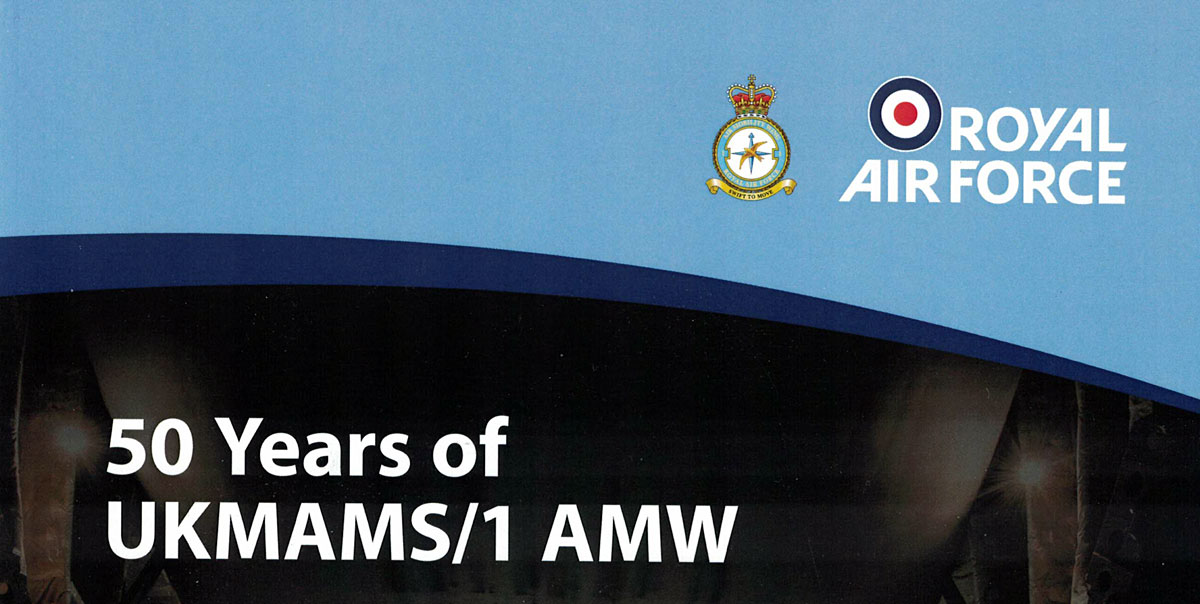
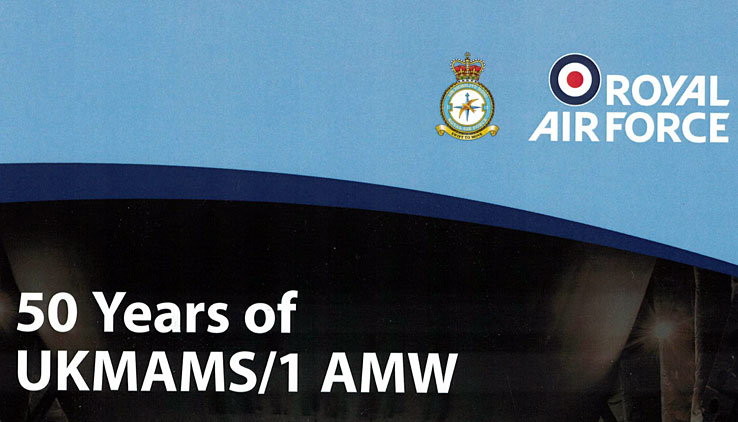
From: Tony Freeman, Thornhill, Dumfries
Subject: Operation Granby
Thank you Tony,
What may not be widely known is that the two auxiliary squadrons, 4624 (Movements) and 4626 (Aeromedical Evacuation) that were mobilised for Op Granby had to volunteer to be mobilised. This is because, under the current Reserve Forces Act in force at the time, the RAuxAF could not be called out in circumstances less than actual or imminent attack on the United Kingdom. Therefore, I spent the whole of the Saturday prior to mobilisation, telephoning my three operational flights (some 100 personnel) to ask, "Would you mind awfully being called up to go to war?" Shades of Sergeant Wilson perhaps!
Ironically, a case of volunteering twice as it were. It is to the everlasting credit that, notwithstanding the thought of losing their job and leaving families to fend for themselves, with one exception, every man and woman turned up for mobilisation. Moreover, at that time, there was no mechanism in place to notify the parent station admin staff of the personal details of those involved so the regular station welfare system did not cover reservists.
Subject: Operation Granby
Thank you Tony,
What may not be widely known is that the two auxiliary squadrons, 4624 (Movements) and 4626 (Aeromedical Evacuation) that were mobilised for Op Granby had to volunteer to be mobilised. This is because, under the current Reserve Forces Act in force at the time, the RAuxAF could not be called out in circumstances less than actual or imminent attack on the United Kingdom. Therefore, I spent the whole of the Saturday prior to mobilisation, telephoning my three operational flights (some 100 personnel) to ask, "Would you mind awfully being called up to go to war?" Shades of Sergeant Wilson perhaps!
Ironically, a case of volunteering twice as it were. It is to the everlasting credit that, notwithstanding the thought of losing their job and leaving families to fend for themselves, with one exception, every man and woman turned up for mobilisation. Moreover, at that time, there was no mechanism in place to notify the parent station admin staff of the personal details of those involved so the regular station welfare system did not cover reservists.
There is no doubt that the 'Oggies' provided much needed support to the hard-pressed regular movers and aeromeds at that time. The movers in particular needed a little time to acclimatise, unlike the medics who were holding down their skills in civilian life, but in no time, the former were humping and dumping with the rest.
I hope that these few words in your journal gives due recognition to those involved, for which, unlike our our American cousins, a mobilisation medal for reservists was sadly lacking.
Tony Freeman
I hope that these few words in your journal gives due recognition to those involved, for which, unlike our our American cousins, a mobilisation medal for reservists was sadly lacking.
Tony Freeman
From: Steve Cross, Doncaster, South Yorks
Subject: Operation Granby - plus - My Swan-Song
Hi Tony,
Subject: Operation Granby - plus - My Swan-Song
Hi Tony,
Thanks for evoking memories of over a quarter of a century ago! This is my story of an interesting last few months in the mob.
After a tour on UKMAMS, I was posted as a young Corporal to MSF duties at RAF Coningsby (with Fg Off John Ellis, Sgt Steve Williams, SAC Ian Robinson et al). During 1990 I had returned from a tour in the Falklands and in the spring of my final year in the RAF I was treated to six weeks at International Air Defence School (IADS) in Penang/Butterworth (with 5 Sqn RAF Coningsby & 23 Sqn from RAF Leeming -FS Mick Mayberry).
In the summer I was on detachment to Akrotiri as part of my final swan song supporting 5 and 29 Tornado F3 squadrons, when Saddam decided to invade Kuwait on 2/3 August.
As the squadron detachment waited patiently for their next orders in response, I started basic load planning and determining the number of possible aircraft required to move the two Squadrons. By 9/10th August the Squadron were put on alert to move to Dhahran in Saudi Arabia and my chalk planning went live.
After a tour on UKMAMS, I was posted as a young Corporal to MSF duties at RAF Coningsby (with Fg Off John Ellis, Sgt Steve Williams, SAC Ian Robinson et al). During 1990 I had returned from a tour in the Falklands and in the spring of my final year in the RAF I was treated to six weeks at International Air Defence School (IADS) in Penang/Butterworth (with 5 Sqn RAF Coningsby & 23 Sqn from RAF Leeming -FS Mick Mayberry).
In the summer I was on detachment to Akrotiri as part of my final swan song supporting 5 and 29 Tornado F3 squadrons, when Saddam decided to invade Kuwait on 2/3 August.
As the squadron detachment waited patiently for their next orders in response, I started basic load planning and determining the number of possible aircraft required to move the two Squadrons. By 9/10th August the Squadron were put on alert to move to Dhahran in Saudi Arabia and my chalk planning went live.
In the space of circa 72 hours, we had to work through bringing together and prepping some 32 aircraft loads, organise their transit from the detachment location to the main pan over half a mile away in the correct order without any form of communication other than passing messages between 5 & 29 squadron personnel acting as drivers and Akrotiri movers. Occasionally I could free myself up to jump in a Landrover and liaise directly between movers. 36 hours of solid work and the growing demand for transit accommodation left me with nowhere to sleep, so I was given permission to requisite the SWOs office and found myself spending the rest of my time at Akrotiri sleeping in his office! (Al Hart take note!)
After 5 & 29 Squadrons had been dispatched, I spent a few weeks helping out the local movers. The build up was impressive, mass aircraft movements resulting in a collection of the machinery & munitions for the possibility of war on a scale I hadn't seen since Operation Corporate.
By mid/late September, I was back at Coningsby. With all available aircraft and equipment deployed, the MSF team instinctively wanted to continue our involvement and we formed a regional mobile capability role to assist RAF Marham and Coltishall MSF teams to deploy their Tornado & Jaguar squadrons into theatre.
After 5 & 29 Squadrons had been dispatched, I spent a few weeks helping out the local movers. The build up was impressive, mass aircraft movements resulting in a collection of the machinery & munitions for the possibility of war on a scale I hadn't seen since Operation Corporate.
By mid/late September, I was back at Coningsby. With all available aircraft and equipment deployed, the MSF team instinctively wanted to continue our involvement and we formed a regional mobile capability role to assist RAF Marham and Coltishall MSF teams to deploy their Tornado & Jaguar squadrons into theatre.
As the build up of coalition forces continued, in December I was detached to Brize on shift as a traffic team leader supplementing the base teams or replacing other movers as they provided additional support in the Middle East.
That was the end of my swan song year and amazingly at the beginning of January 1991, I was released from Brize to attend a resettlement course at the London Business School, which started during the period of hostilities. This was a surreal time. By the time the ground war had finished, so had the course. Within a few short months I had become a civvy.
Interestingly at the 50th anniversary hanger bash, I bumped into (amongst others) a very surprised Ian Robinson (no longer a SAC). We hadn't seen each other for over 25 years. Great to see lots of current & ex-movers enjoying the celebrations. Ray Roberts and I were very interested in what movers have progressed onto on leaving the services and were curious as to what is the most obscure jobs our members have done. Mine was as a canal transport operations manager. Anyone else had a strange or very rare job?
Keep up the great work Tony!
Best wishes to all.
Steve Cross
That was the end of my swan song year and amazingly at the beginning of January 1991, I was released from Brize to attend a resettlement course at the London Business School, which started during the period of hostilities. This was a surreal time. By the time the ground war had finished, so had the course. Within a few short months I had become a civvy.
Interestingly at the 50th anniversary hanger bash, I bumped into (amongst others) a very surprised Ian Robinson (no longer a SAC). We hadn't seen each other for over 25 years. Great to see lots of current & ex-movers enjoying the celebrations. Ray Roberts and I were very interested in what movers have progressed onto on leaving the services and were curious as to what is the most obscure jobs our members have done. Mine was as a canal transport operations manager. Anyone else had a strange or very rare job?
Keep up the great work Tony!
Best wishes to all.
Steve Cross
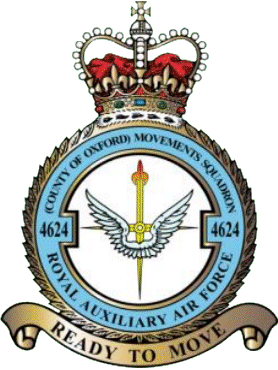
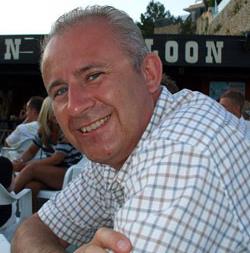
From: David Powell, Princes Risborough
Subject: Operation Granby
Hi Tony,
Op Granby from the very blunt end
My last tour was at the MoD from 1990 to 1993 in the Log Ops shop, the focal point for logistic support of RAF deployed operations and major exercises. As such I had a seat in the stalls for the whole event from the invasion of Kuwait and the deployment of Jaguars in response, the main operation, the recovery phase and the subsequent no-fly zone deployments. After 25 years what memories stand out?
The office was an integrated logistics team, with engineers as well as suppliers. We covered all aspects of off-base operational support. The months leading up to the operation were a bit of a blur. But, one afternoon still stands out. The exam question was ‘How many body bags do we need to deploy and to where?’ So, talk to army colleagues, medics, chemical warfare experts, intelligence; factor in how many RAF personnel we will have deployed. Then sit down, do the worst case calculations and draft the deployment task instructions. Thankfully, that was one calculation which did not come to be tested in anger.
For the war itself, I have two very different yet equally vivid memories. The first was the incredible secrecy maintained over the actual H-Hour decision. Even within the MoD’s Air Force Ops room, very, very few individuals knew in advance. In peacetime, the Ops Room had a very small 24/7 staff. During a crisis, its various specialist desks were manned up by appropriate specialists. For logistics, our office was the first call for any questions from the Ops Room. We would either field or cascade out to the appropriate specialist. For operations such as Granby and the extensive lead-up the various specialist desks had been activated, with the logs desk manned by our office plus reinforcements to give 24/7 cover as well as sustaining the office.
Subject: Operation Granby
Hi Tony,
Op Granby from the very blunt end
My last tour was at the MoD from 1990 to 1993 in the Log Ops shop, the focal point for logistic support of RAF deployed operations and major exercises. As such I had a seat in the stalls for the whole event from the invasion of Kuwait and the deployment of Jaguars in response, the main operation, the recovery phase and the subsequent no-fly zone deployments. After 25 years what memories stand out?
The office was an integrated logistics team, with engineers as well as suppliers. We covered all aspects of off-base operational support. The months leading up to the operation were a bit of a blur. But, one afternoon still stands out. The exam question was ‘How many body bags do we need to deploy and to where?’ So, talk to army colleagues, medics, chemical warfare experts, intelligence; factor in how many RAF personnel we will have deployed. Then sit down, do the worst case calculations and draft the deployment task instructions. Thankfully, that was one calculation which did not come to be tested in anger.
For the war itself, I have two very different yet equally vivid memories. The first was the incredible secrecy maintained over the actual H-Hour decision. Even within the MoD’s Air Force Ops room, very, very few individuals knew in advance. In peacetime, the Ops Room had a very small 24/7 staff. During a crisis, its various specialist desks were manned up by appropriate specialists. For logistics, our office was the first call for any questions from the Ops Room. We would either field or cascade out to the appropriate specialist. For operations such as Granby and the extensive lead-up the various specialist desks had been activated, with the logs desk manned by our office plus reinforcements to give 24/7 cover as well as sustaining the office.
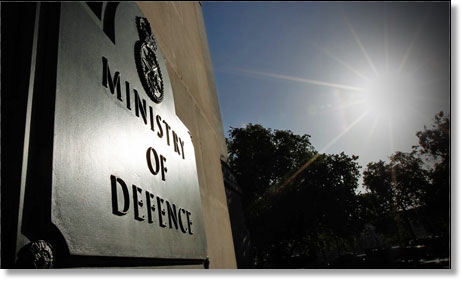
My normal routine was to drive in early from our home at Princes Risborough; sit in for the daily morning Air Force Ops brief and logs desk handover. During the day, walk abouts around the various specialist cells, and role offices, such as fuels and the movers and then cover the evening briefs and hand-overs before working late in my own office and then staying overnight in London.
I would repeat this pattern for two or three days before leaving mid-afternoon; drive home via the Strike Command operational headquarters near High Wycombe to share, pick up on and discuss the latest emerging thinking/initiatives with support implications before heading the 5 miles to where we lived for a few hours in my own bed, before collecting some changes of clothes and then repeating the pattern. This way I could maintain pretty good overview of what was a very dynamic situation and attempt to pre-empt the next support challenge that could be formally heading up or down the command chain. In the 1980s American management guru Tom Peters made a fortune by promoting this approach which he called managing by walking about (MBWA). In the 1960s I had learnt the hard way during my very first tour that most specialisations and roles haven’t a clue about what logisticians can do, and it was up to the logistician to go to the customers and learn to speak their respective jargons.
I would repeat this pattern for two or three days before leaving mid-afternoon; drive home via the Strike Command operational headquarters near High Wycombe to share, pick up on and discuss the latest emerging thinking/initiatives with support implications before heading the 5 miles to where we lived for a few hours in my own bed, before collecting some changes of clothes and then repeating the pattern. This way I could maintain pretty good overview of what was a very dynamic situation and attempt to pre-empt the next support challenge that could be formally heading up or down the command chain. In the 1980s American management guru Tom Peters made a fortune by promoting this approach which he called managing by walking about (MBWA). In the 1960s I had learnt the hard way during my very first tour that most specialisations and roles haven’t a clue about what logisticians can do, and it was up to the logistician to go to the customers and learn to speak their respective jargons.
Anyway, I was on an overnight stay in London when I woke up during the night, made a brew and switched on the TV, to find that CNN were reporting that all hell had let loose. So apart from a quick phone to my two star (we had been junior officers together at Abingdon) who was equally in the dark, headed for Air Force Ops. Interestingly, talking later to the duty logs desk man, he had been one of the few to twig that the war had been about to start. Earlier in his shift, during a quiet spell he had been trawling through the real-time totes of some of the in-theatre airfields, and happened to note that the weapon stock levels were dropping indicating a major outload was underway. He had brought this to the attention of the Ops Room Controller, one of the very few to be ‘in the know’, who told him in no uncertain terms that ‘he had not seen anything!’
The other memory of this period was that for some reason the Air Space Management Aid had acquired a crossed wire in some communications satellite so that when a Scud Missile attack air raid alert was sounded at the forward bases, it also went off in my office in London!
The other memory of this period was that for some reason the Air Space Management Aid had acquired a crossed wire in some communications satellite so that when a Scud Missile attack air raid alert was sounded at the forward bases, it also went off in my office in London!
While for some, Op Granby was just a few hours of hell, or days of tension or weeks of hard work, we lived with this file for months if not years. Once the operational phases were over, it was kit recovery time to be monitored. And, time to collect and analyse the inevitable ‘lessons learned”. Last memory - having collected what appeared to be the consensus ‘top 20 lessons learnt’, we went on a road show for conversations with the main players. The format I presented was that I would run through the top 20 key lessons, and then the audience could chose the top half dozen they found the most relevant/interesting for more detailed conversation. I would produce ‘the list’ and start reading, usually received with much nodding of agreement etc., until I came to lesson number 20 - ‘Must improve refuelling capability at Ascension Island’. At which stage I would admit that I had raided the files and had been reading the lessons from the 1982 Falklands Campaign. How does the refrain from the Peter Paul and Mary song go? ♪‘When will they ever learn? ♫ When will they ever learn?’♪
Stay safe
David Powell
F Team UKMAMS Abingdon 1967-69
Stay safe
David Powell
F Team UKMAMS Abingdon 1967-69
From: Mike Stoddard, Carrying Place, ON
Subject: (Operation Granby)
Hi Tony,
Subject: (Operation Granby)
Hi Tony,
After Saddam's invasion in Kuwait, I was sent to Doha, Qatar (1st pic) as line Sgt of 2 Air Mov Sqn Trenton MAMS team. We were there nearly a month building loads, loading aircraft for redeployment to Canada and Lahr, Germany. Despite the heat, long hours and shortage of beer (had to be snuck in from Lahr) the team worked well and did an excellent job to accomplish the mission
Several months later I was sent to Kuwait (2nd pic), this time with only two other MAMS members. We were there to build loads to redeploy 1 CER (Engineers) back to Canada. The fires were still burning in Kuwait at that time. While there the engineers took us for a nine-hour trip throughout the desert and into Iraq (pics 3 and 4). We got to see the the Iraqi trenches (some still filled with oil), lots of destroyed vehicles etc. I managed to scavenge a bunch of 155 Russian artillery brass shell casings and Iraqi helmets, some of which I brought back to Canada. Lots of hard work and great memories with 2 Air Movements MAMS teams.
Mike Stoddard (retd)
Several months later I was sent to Kuwait (2nd pic), this time with only two other MAMS members. We were there to build loads to redeploy 1 CER (Engineers) back to Canada. The fires were still burning in Kuwait at that time. While there the engineers took us for a nine-hour trip throughout the desert and into Iraq (pics 3 and 4). We got to see the the Iraqi trenches (some still filled with oil), lots of destroyed vehicles etc. I managed to scavenge a bunch of 155 Russian artillery brass shell casings and Iraqi helmets, some of which I brought back to Canada. Lots of hard work and great memories with 2 Air Movements MAMS teams.
Mike Stoddard (retd)
10 reasons why being a pilot isn't as cool as you think
(and 1 that makes it all worthwhile)
(and 1 that makes it all worthwhile)
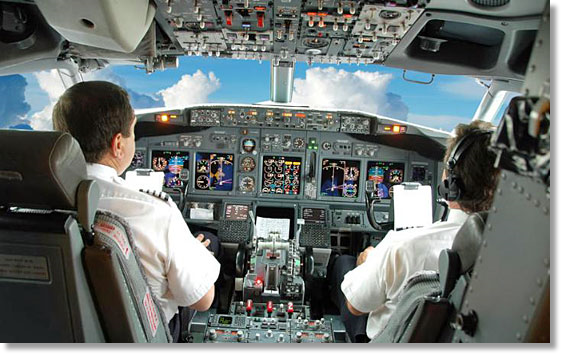
1. We don’t make as much money as you think. As of May 2014, the average pilot income was $75,000. That’s an average. My salary in the first year with the airlines, based out of New York’s JFK International Airport, was $21,109. This is why pilots fall on a free continental breakfast like locusts. The days of making $300,000 a year for five days of work per month went out with smoking on an airplane.
2. We don’t see our families too often. In a 30-day month, the average airline pilot will only work 12-15 days. But when you consider that most pilots commute to work from out of state, a normal four-day trip actually takes six days to complete. If a pilot gets two assignments back-to-back with insufficient time in between to return home, he or she could be gone for weeks at a time.
3. Just because we fly to exotic destinations doesn’t mean we get to see them. Once, when queried by a friend as to what Belfast, Ireland, looked like, I simply replied, “Cleveland.” For the most part, layovers are so short that a pilot will stay at a hotel with a view of the airport he or she just landed at. In most cases you have enough time to shower, eat, get some rest, and be ready to do it all again tomorrow.
2. We don’t see our families too often. In a 30-day month, the average airline pilot will only work 12-15 days. But when you consider that most pilots commute to work from out of state, a normal four-day trip actually takes six days to complete. If a pilot gets two assignments back-to-back with insufficient time in between to return home, he or she could be gone for weeks at a time.
3. Just because we fly to exotic destinations doesn’t mean we get to see them. Once, when queried by a friend as to what Belfast, Ireland, looked like, I simply replied, “Cleveland.” For the most part, layovers are so short that a pilot will stay at a hotel with a view of the airport he or she just landed at. In most cases you have enough time to shower, eat, get some rest, and be ready to do it all again tomorrow.
4. We hate delays as much as you do. Pilots hate delays for two reasons: First, as stated above, downtime is at a minimum at the destination already. Any time spent in delay just means there will be less time to actually explore or unwind once you land. Second, pilots are paid based on actual flight hours. So any time spent perusing the magazine rack while delayed means you’re at work but not getting paid. (To put salt in the wound, refer back to #1.)
5. We spend a lot of time at places called “crash pads.” I’ve always found it a little ironic that the temporary housing for pilots is called a crash pad. I would have voted for “land safely pad.” Truth is, pilots need a place to stay between trips - when commuting in the night before a trip, or when a schedule deems that a pilot be on call or “reserve.” It works like this: You rent a bunkbed in a four-bedroom apartment with 30 other pilots for around $300 per month. My first year at the airlines, I spent more nights sleeping on Incredible Hulk sheets in a bunkbed in Queens than I did at home.
6. The community isn’t as tight as you’d think. There’s a common misconception that all pilots know each other. The truth is most pilots from the same airline don’t even know each other. As you sit by your gate and watch the captain and first officer shake hands, chances are that’s the first time they’ve ever met. And after 30 hours in the air and four days on the road, that will probably be the last time they ever fly together.
7. We have to be very careful with alcohol. The mantra of drinking aviators is “eight hours bottle to throttle” (12 hours at some airlines), meaning that on layovers a pilot must finish the last cocktail and practice an eight-hour prohibition before getting back in the cockpit. This fact on an already short layover, coupled with expensive hotel lobby bars (when making a little over $20,000 a year), and the threat of a random breathalyzer at your gate, persuades most to wait until they get home.
5. We spend a lot of time at places called “crash pads.” I’ve always found it a little ironic that the temporary housing for pilots is called a crash pad. I would have voted for “land safely pad.” Truth is, pilots need a place to stay between trips - when commuting in the night before a trip, or when a schedule deems that a pilot be on call or “reserve.” It works like this: You rent a bunkbed in a four-bedroom apartment with 30 other pilots for around $300 per month. My first year at the airlines, I spent more nights sleeping on Incredible Hulk sheets in a bunkbed in Queens than I did at home.
6. The community isn’t as tight as you’d think. There’s a common misconception that all pilots know each other. The truth is most pilots from the same airline don’t even know each other. As you sit by your gate and watch the captain and first officer shake hands, chances are that’s the first time they’ve ever met. And after 30 hours in the air and four days on the road, that will probably be the last time they ever fly together.
7. We have to be very careful with alcohol. The mantra of drinking aviators is “eight hours bottle to throttle” (12 hours at some airlines), meaning that on layovers a pilot must finish the last cocktail and practice an eight-hour prohibition before getting back in the cockpit. This fact on an already short layover, coupled with expensive hotel lobby bars (when making a little over $20,000 a year), and the threat of a random breathalyzer at your gate, persuades most to wait until they get home.
8. Although we get to fly for free on our days off, it’s not as great as it sounds. After 25 days of flying, the last thing I want to do is climb back in that metal tube and go somewhere. This job perk isn’t actually a confirmed free ticket. It’s simply the opportunity to fill any empty seat on an airplane. If flights to your destination have canceled and they’re trying to get paying customers to their destination by filling the next flight, your vacation may be delayed by days.
9. Holidays are not sacred. The busiest travel days of the year happen to be holidays. While your family is opening gifts buzzed on eggnog, you’re stuck in some airport hotel trying to find the only open restaurant in town. Since the airlines don’t find holidays sacred, forget ever being home for an anniversary or birthday.
10. We’re even more bored in the air than you are. According to the rules, there are not to be any reading materials in the cockpit with the exception of pertinent manuals. While passengers kick back to read that new softcover purchased specifically for the long flight, your pilots are staring at needles and gauges watching every minute go by. If your copilot and you don’t quite “click,” a six-hour flight can feel like an eternity.
And why, despite the above, it’s all worth it… So why do pilots keep coming back for more? I give this example: It was on a night flight from Calgary to Belfast. As we first started to cross the ocean, we could see below that a series of thunderstorms were in full swing. The blasts of light rivaled even the best firework shows. Without notice, a green glow began to fill the horizon. The aurora borealis had started its own show. As we watched both beautiful natural phenomena in crescendo, my co-pilot broke the awed silence to say, “Well, this is why we do what we do.”
Aviation News
9. Holidays are not sacred. The busiest travel days of the year happen to be holidays. While your family is opening gifts buzzed on eggnog, you’re stuck in some airport hotel trying to find the only open restaurant in town. Since the airlines don’t find holidays sacred, forget ever being home for an anniversary or birthday.
10. We’re even more bored in the air than you are. According to the rules, there are not to be any reading materials in the cockpit with the exception of pertinent manuals. While passengers kick back to read that new softcover purchased specifically for the long flight, your pilots are staring at needles and gauges watching every minute go by. If your copilot and you don’t quite “click,” a six-hour flight can feel like an eternity.
And why, despite the above, it’s all worth it… So why do pilots keep coming back for more? I give this example: It was on a night flight from Calgary to Belfast. As we first started to cross the ocean, we could see below that a series of thunderstorms were in full swing. The blasts of light rivaled even the best firework shows. Without notice, a green glow began to fill the horizon. The aurora borealis had started its own show. As we watched both beautiful natural phenomena in crescendo, my co-pilot broke the awed silence to say, “Well, this is why we do what we do.”
Aviation News
From: John Kilpatrick, Weston-Super-Mare
Subject: Operation Corporate
Hi Tony,
Just been reading the last couple of Old Bods and want to put the records straight. Andy Holliday was correct in his first article, it was John (Killer) Kilpatrick 79-88 who had the pleasure of his company in the Falklands and not Alan (Strawhead) Kilpatrick 1966-78.
Regards
Killer!
Subject: Operation Corporate
Hi Tony,
Just been reading the last couple of Old Bods and want to put the records straight. Andy Holliday was correct in his first article, it was John (Killer) Kilpatrick 79-88 who had the pleasure of his company in the Falklands and not Alan (Strawhead) Kilpatrick 1966-78.
Regards
Killer!
From: John Kilpatrick, Weston-Super-Mare
Subject: Operation Corporate
Hi Tony,
Just been reading the last couple of Old Bods and want to put the records straight. Andy Holliday was correct in his first article, it was John (Killer) Kilpatrick 79-88 who had the pleasure of his company in the Falklands and not Alan (Strawhead) Kilpatrick 1966-78.
Regards
Killer!
Subject: Operation Corporate
Hi Tony,
Just been reading the last couple of Old Bods and want to put the records straight. Andy Holliday was correct in his first article, it was John (Killer) Kilpatrick 79-88 who had the pleasure of his company in the Falklands and not Alan (Strawhead) Kilpatrick 1966-78.
Regards
Killer!
From: Steve Munday, Woodhall Spa, Lincs
Subject: RE: UKMAMS OBA OBB #052716
Hi Tony,
Many thanks for the OBA Newsletters they are most welcome for keeping in touch with old friends and colleagues. Keep up the good work.
Regarding Op Corporate; I note in the last letter that Andy Holliday has apologised to Alan Kilpatrick. Perhaps he cannot remember that it was actually me that went down with him on Ascot 4250 (I don’t think Steve Williams was on it). At least Jim Rice got it right! Never mind Andy it was a long time ago.
Best regards
Steve Munday
Subject: RE: UKMAMS OBA OBB #052716
Hi Tony,
Many thanks for the OBA Newsletters they are most welcome for keeping in touch with old friends and colleagues. Keep up the good work.
Regarding Op Corporate; I note in the last letter that Andy Holliday has apologised to Alan Kilpatrick. Perhaps he cannot remember that it was actually me that went down with him on Ascot 4250 (I don’t think Steve Williams was on it). At least Jim Rice got it right! Never mind Andy it was a long time ago.
Best regards
Steve Munday
How to contact OBA Members
1) The Members Listings are available at http://ukmamsoba.org/members.htm Just click on the air force roundal in the crate at the top right of the page (it defaults to RAF) and then if either RAF or RCAF are selected click the alphabetic icon. For RAAF and RNZAF clicking on either the Roo or Kiwi will take you directly to the listings. Scroll down the page until you find the target name. All of the information is there; their e-mail address resides in the penultimate column under their first name (or nick name in some cases). If you don't have an on-board e-mail client such as Outlook on your 'puter, then right click their first name for the contextual menu where you will get the option to copy the e-mail address to your clipboard.
2) MAMS OBA Earth - http://www.easymapmaker.com/map/mams_oba_earth is a Google map that I generated using member's information. There is a Search Box at the top right - just put in a partial or complete name, hit Enter, and then choose your target from the drop down list. This will then zoom in on the pin for your target. Clicking on the pin will give you a pop-up window of their pertinent information. Taking it one step further; by dragging the little orange figure of the man in the bottom right of the screen over the street adjacent to where the pin is located will produce a street view of the area where their home is - the street view is generated by the postal code (if a street address is provided then the street view will be exact). In order to get back to your map screen just click the little left arrow (not the browser back arrow) at the top left of your screen.
3) The OBA Briefs http://ukmamsoba.org/briefs.htm When a person's letter is published in the newsletter, there's a plethora of information just on the first line; you see the person's first and last name and their residence location, then the flags that appear following that indicate the country they are living in followed by the air force that they are associated with (sometimes there are two air force flags indicating they have served in both). Left clicking on the flags will bring up an e-mail compose screen with their address filled in - or in the case of not having an on board e-mail client, right click in order to get the option to copy the address to your clipboard.
Have fun!
2) MAMS OBA Earth - http://www.easymapmaker.com/map/mams_oba_earth is a Google map that I generated using member's information. There is a Search Box at the top right - just put in a partial or complete name, hit Enter, and then choose your target from the drop down list. This will then zoom in on the pin for your target. Clicking on the pin will give you a pop-up window of their pertinent information. Taking it one step further; by dragging the little orange figure of the man in the bottom right of the screen over the street adjacent to where the pin is located will produce a street view of the area where their home is - the street view is generated by the postal code (if a street address is provided then the street view will be exact). In order to get back to your map screen just click the little left arrow (not the browser back arrow) at the top left of your screen.
3) The OBA Briefs http://ukmamsoba.org/briefs.htm When a person's letter is published in the newsletter, there's a plethora of information just on the first line; you see the person's first and last name and their residence location, then the flags that appear following that indicate the country they are living in followed by the air force that they are associated with (sometimes there are two air force flags indicating they have served in both). Left clicking on the flags will bring up an e-mail compose screen with their address filled in - or in the case of not having an on board e-mail client, right click in order to get the option to copy the address to your clipboard.
Have fun!
Farnborough Air Display 1964
RAF man prepares for take off at 80 - on the wing of a biplane!
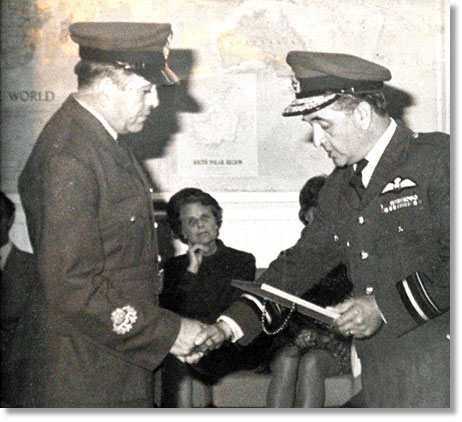
Former RAF man John Brown takes to the skies again this summer nearly 30 years after he retired from the military. When other 80-year-olds are celebrating their birthdays from a comfy chair, he’ll be strapped to the top wing of a 1940s bi-plane zooming around the skies over a First World War airfield.
The veteran of 33 years as an Air Loadmaster is raising money for Wiltshire Air Ambulance in memory of his wife Thelma, who died five years ago. He said: “She used to enjoy watching the helicopter coming in to the Great Western Hospital. She took a great interest in that because she was the wife of an aviator. It was part of her life, living on airfields.”
Ever since her death five years ago John has made regular donations to the air ambulance. But the great grandfather from Upper Stratton, who plays bowls, walking football and table tennis, decided he wanted to do something different. He explained: “The reason why I’m so active is that I spent 14 years looking after my wife who was seriously ill and disabled. I couldn’t go to the pub, I couldn’t do sport, we couldn’t even have people over to dinner.”
Mr Brown, who was awarded for exceptional work on Hercules aircraft, went all over the world before he retired in 1987 from 216 Sqn at RAF Brize Norton where he had been working on Tristars. He was responsible for loading aircraft with all kinds of freight and passengers from soldiers to food supplies.
The veteran of 33 years as an Air Loadmaster is raising money for Wiltshire Air Ambulance in memory of his wife Thelma, who died five years ago. He said: “She used to enjoy watching the helicopter coming in to the Great Western Hospital. She took a great interest in that because she was the wife of an aviator. It was part of her life, living on airfields.”
Ever since her death five years ago John has made regular donations to the air ambulance. But the great grandfather from Upper Stratton, who plays bowls, walking football and table tennis, decided he wanted to do something different. He explained: “The reason why I’m so active is that I spent 14 years looking after my wife who was seriously ill and disabled. I couldn’t go to the pub, I couldn’t do sport, we couldn’t even have people over to dinner.”
Mr Brown, who was awarded for exceptional work on Hercules aircraft, went all over the world before he retired in 1987 from 216 Sqn at RAF Brize Norton where he had been working on Tristars. He was responsible for loading aircraft with all kinds of freight and passengers from soldiers to food supplies.
In 1971 he was part of the crew sent to support Prince Charles during the independence celebrations for Fiji. And the job was not without its perks. On one trip he found himself billeted by himself in the honeymoon suite at the Hilton in Bermuda.
Because his role sometimes involved sending paratroopers out of the aircraft door he had to make a couple of parachute jumps himself so he could understand what it was all about. “I would never do it again,” he said firmly. “It isn’t too bad jumping out and floating down under the canopy looking round at the scenery is fantastic. But I couldn’t judge when I was going to hit the ground and I hit it like a sack of potatoes.”
But he is looking forward to the wingwalk at Rendcomb Airfield near Cirencester. “I’m not apprehensive about it. I’ve passed the medical and I’ve already climbed onto the top wing unaided.” His family will be at the airfield on August 17 to see him take off. He has already raised more than £100 in sponsorship and with the help of his old squadron associations, aims to raise even more.
If anyone wants to sponsor him online they can make a donation direct to the air ambulance in his name at http://wiltshireairambulance.co.uk
Swindon Advertiser
Because his role sometimes involved sending paratroopers out of the aircraft door he had to make a couple of parachute jumps himself so he could understand what it was all about. “I would never do it again,” he said firmly. “It isn’t too bad jumping out and floating down under the canopy looking round at the scenery is fantastic. But I couldn’t judge when I was going to hit the ground and I hit it like a sack of potatoes.”
But he is looking forward to the wingwalk at Rendcomb Airfield near Cirencester. “I’m not apprehensive about it. I’ve passed the medical and I’ve already climbed onto the top wing unaided.” His family will be at the airfield on August 17 to see him take off. He has already raised more than £100 in sponsorship and with the help of his old squadron associations, aims to raise even more.
If anyone wants to sponsor him online they can make a donation direct to the air ambulance in his name at http://wiltshireairambulance.co.uk
Swindon Advertiser
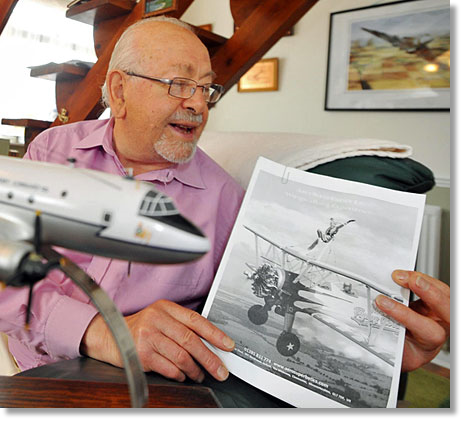
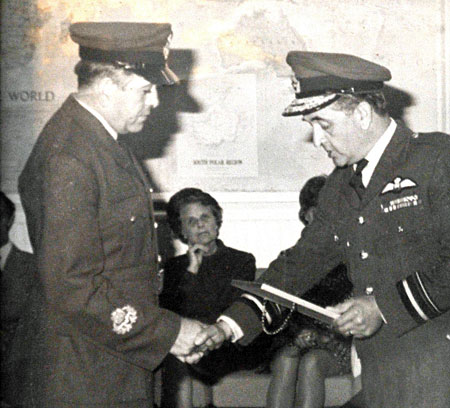
From: Paul Austin, High Wycombe
Subject: 68th Annual Air Movements Officers' Reunion
Subject: 68th Annual Air Movements Officers' Reunion

Tony,
Would you kindly publish the advance notice regarding the Annual Movements Officers' Reunion. The date is Friday 4th November 2016 starting at 1830. Details can be found via LogWeb, but anyone requiring any assistance can get in touch with me.
Regards,
Paul Austin
Would you kindly publish the advance notice regarding the Annual Movements Officers' Reunion. The date is Friday 4th November 2016 starting at 1830. Details can be found via LogWeb, but anyone requiring any assistance can get in touch with me.
Regards,
Paul Austin
From: Paul Austin, High Wycombe
Subject: 68th Annual Air Movements Officers' Reunion
Subject: 68th Annual Air Movements Officers' Reunion

Tony,
Would you kindly publish the advance notice regarding the Annual Movements Officers' Reunion. The date is Friday 4th November 2016 starting at 1830. Details can be found via LogWeb, but anyone requiring any assistance can get in touch with me.
Regards,
Paul Austin
Would you kindly publish the advance notice regarding the Annual Movements Officers' Reunion. The date is Friday 4th November 2016 starting at 1830. Details can be found via LogWeb, but anyone requiring any assistance can get in touch with me.
Regards,
Paul Austin
From: Howard Farrow, Stafford
Subject: Movers in Masirah 72/73
Hi Tony,
Here are some pictures I came across of Movers in Masirah circa 72/73, Five-a-Side Footy and Fishing Off The Jetty. Can the lads name them? Happy days in the sun eh!
Best to all,
Howard (Taff) Farrow
Subject: Movers in Masirah 72/73
Hi Tony,
Here are some pictures I came across of Movers in Masirah circa 72/73, Five-a-Side Footy and Fishing Off The Jetty. Can the lads name them? Happy days in the sun eh!
Best to all,
Howard (Taff) Farrow
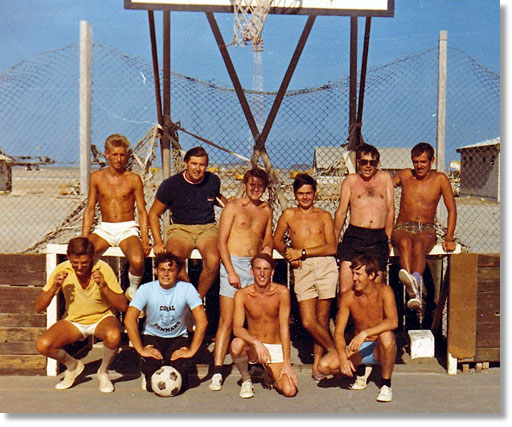
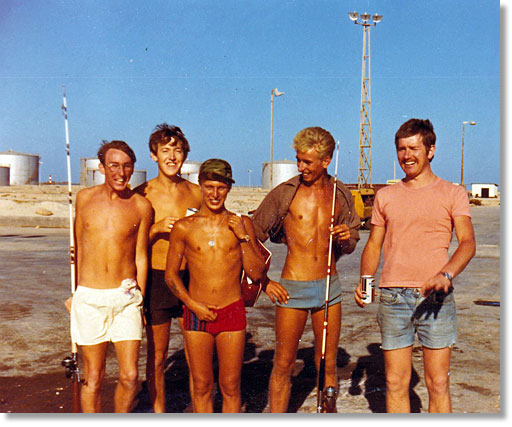
The 25th anniversary of the crash of Boxtop 22
From: John Bell, Desborough, Northants
Subject: Where are they?
Tony,
I am trying to find the whereabouts of Bob (Robert P) Wonnacott. Bob was a Supply Admin Apprentice with me in 1957/8 at RAF Hereford in the 31st Entry (as was Chas Cormack). I have traced a few of my old mates from the 31st and would like to find Bob. I don't think he became a mover either as a Q Mov or Mov Controller but probably stayed in Supply. Like me and Chas he will be 75 years old or thereabouts.
Many thanks
John
Subject: Where are they?
Tony,
I am trying to find the whereabouts of Bob (Robert P) Wonnacott. Bob was a Supply Admin Apprentice with me in 1957/8 at RAF Hereford in the 31st Entry (as was Chas Cormack). I have traced a few of my old mates from the 31st and would like to find Bob. I don't think he became a mover either as a Q Mov or Mov Controller but probably stayed in Supply. Like me and Chas he will be 75 years old or thereabouts.
Many thanks
John
From: John Middleton, Huntingdon, Cambs
Subject: Where are they?
Hi Tony,
Subject: Where are they?
Hi Tony,
Ron Smith on the left and John Middleton on the right. I've forgotton who the chap in the middle was
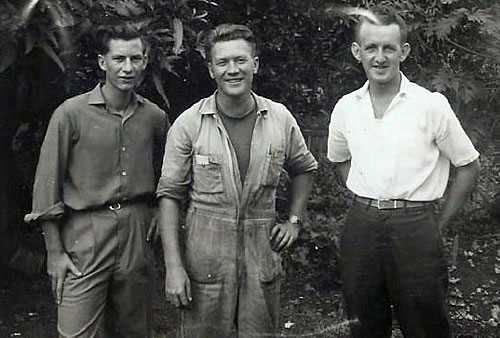
Trying to locate SAC Ron (Smudge) Smith.
During our twelve month stint on Christmas Island, on "Operation Grapple XY& Z" (1957), Smudge and I volunteered for Air Loadmaster duties, due to a period of sickness amongst the established ALM's.
Together we island-hopped around the South Paciific on the islands' resident DC3's. Canton, Samoa, Fiji, Amberley (Aussie), Raratonga, Hickam Field, Hawaii etc., during which we formed a very strong bond.
Coming up to the end of our 12 months tour we volunteered again to fly with a Hastings back to Colerne via the long route; Singapore, Ceylon, Gulf States and Malta, partly retracing our steps as a medevac hence the route time of 14 days.
Ron lived in Croydon and after a 3 year stint in the services returned to the family haulage business where, I regret, contact was lost.
Kind regards
John Middleton
During our twelve month stint on Christmas Island, on "Operation Grapple XY& Z" (1957), Smudge and I volunteered for Air Loadmaster duties, due to a period of sickness amongst the established ALM's.
Together we island-hopped around the South Paciific on the islands' resident DC3's. Canton, Samoa, Fiji, Amberley (Aussie), Raratonga, Hickam Field, Hawaii etc., during which we formed a very strong bond.
Coming up to the end of our 12 months tour we volunteered again to fly with a Hastings back to Colerne via the long route; Singapore, Ceylon, Gulf States and Malta, partly retracing our steps as a medevac hence the route time of 14 days.
Ron lived in Croydon and after a 3 year stint in the services returned to the family haulage business where, I regret, contact was lost.
Kind regards
John Middleton
From: Fred Hebb, Gold River, NS
Subject: Where are they?
Hi Tony,
I had a friend in Greenwood back in the early sixties. His name is Armand Auger and the last time I saw him he was in Dorval. I wouldn't mind catching up with him again.
Thanks
Fred Hebb
Subject: Where are they?
Hi Tony,
I had a friend in Greenwood back in the early sixties. His name is Armand Auger and the last time I saw him he was in Dorval. I wouldn't mind catching up with him again.
Thanks
Fred Hebb
Bits 'n' Pieces

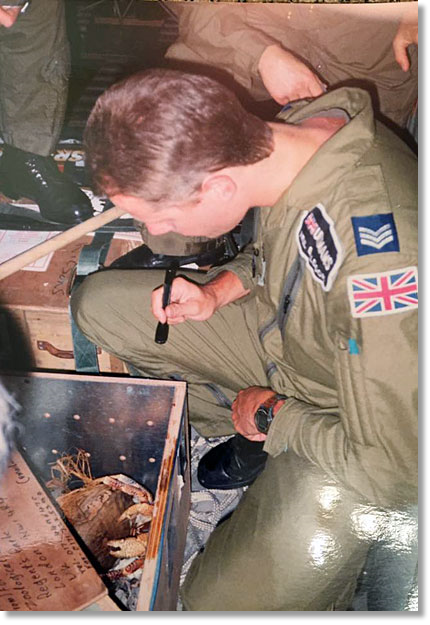
Baggage Labels from back in the day
(courtesy of Ian Berry)
(courtesy of Ian Berry)
March '98 - Neil Baldock is checking on some crabs being transported from the Maldives to London Zoo
Air Force fly Maori and Pasifika artists to Guam
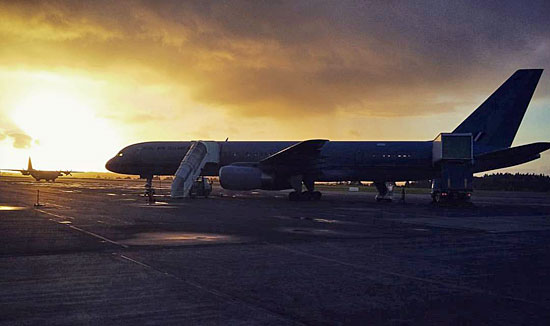
A total of $887,000 in Government funding, including the use of two air force planes, was provided to New Zealand artists taking part in an arts festival in Guam this month.
One hundred Maori and Pasifika artists were flown to Guam by the Royal New Zealand Air Force to take part in the country's Festival of Pacific Arts.
New Zealand's contingent flew to the small pacific island on an RNZAF B757 and their artwork was flown over by a C-130 Hercules.
Flights to Guam, which is a territory of the United States, were typically at least $2500-$3000 return. The total Air Force cost worked out at roughly $2370 per person.
stuff.co.nz
One hundred Maori and Pasifika artists were flown to Guam by the Royal New Zealand Air Force to take part in the country's Festival of Pacific Arts.
New Zealand's contingent flew to the small pacific island on an RNZAF B757 and their artwork was flown over by a C-130 Hercules.
Flights to Guam, which is a territory of the United States, were typically at least $2500-$3000 return. The total Air Force cost worked out at roughly $2370 per person.
stuff.co.nz
From: Colin Turrell
Subject: Guest Book Entry
Hi and great website. My father was W/O Terry Turrell. There are some names I recognize and would love to hear from anybody that knew him as he died about 14 years ago, no doubt loading something somewhere in the Universe. My mother, Carol, died young while dad was at Brize on his last posting, that was 28 years ago.
From: Tony Gale, Gatineau, QC
To: Colin Turrell
Subject: Terry Turrell
Hi Colin,
Thanks for your entry in the UKMAMS OBA Guestbook.
Well, I guess you hit pay dirt as I recall Terry with fondness from a lifetime ago. I was a corporal stationed in Hong Kong back in the mid 70s and Terry was my shift W/O.
I recall there was a very young Flying Officer there as DAMO, a very wet-behind-the-ears… Brian… something or other. Anyway, he had taken the better-than-you attitude on a disagreement with me and was trying to embarrass me in front of everybody on the shift. Your father stepped up and literally went toe-to-toe with this young Fg Off and really ripped him a new one, telling him that if ever he treated “My Boys” like that again he would have to deal with him - and that would not be very pretty (in so many words).
I’ll publish your enquiry in the upcoming newsletter to see if we can get you some more tales about your Dad.
Subject: Guest Book Entry
Hi and great website. My father was W/O Terry Turrell. There are some names I recognize and would love to hear from anybody that knew him as he died about 14 years ago, no doubt loading something somewhere in the Universe. My mother, Carol, died young while dad was at Brize on his last posting, that was 28 years ago.
From: Tony Gale, Gatineau, QC
To: Colin Turrell
Subject: Terry Turrell
Hi Colin,
Thanks for your entry in the UKMAMS OBA Guestbook.
Well, I guess you hit pay dirt as I recall Terry with fondness from a lifetime ago. I was a corporal stationed in Hong Kong back in the mid 70s and Terry was my shift W/O.
I recall there was a very young Flying Officer there as DAMO, a very wet-behind-the-ears… Brian… something or other. Anyway, he had taken the better-than-you attitude on a disagreement with me and was trying to embarrass me in front of everybody on the shift. Your father stepped up and literally went toe-to-toe with this young Fg Off and really ripped him a new one, telling him that if ever he treated “My Boys” like that again he would have to deal with him - and that would not be very pretty (in so many words).
I’ll publish your enquiry in the upcoming newsletter to see if we can get you some more tales about your Dad.
Big Bird has Landed in South Sudan
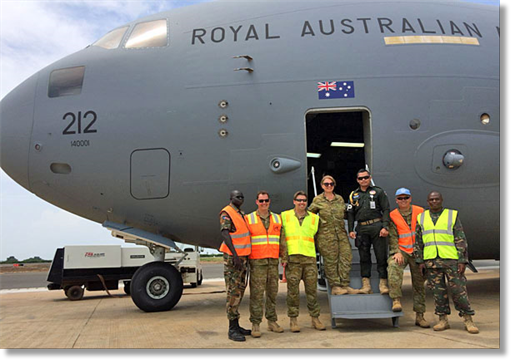
After months of planning, a Royal Australian Air Force C-17A Globemaster III, from Amberley-based No. 36 Squadron, touched down in Juba, South Sudan for the yearly supply run.
The C-17A brought much needed supplies to Australian Defence Force personnel deployed on Operation ASLAN the ADF contribution to the United Nations Mission in South Sudan (UNMISS).
Also intended for a New Zealand Contingent who are working in UNMISS, the flight brought items such as personnel protective equipment, rations, bulk water, weapons and ammunition; as well as other stores that are not readily available in the land locked country. The flight is also used to return ADF equipment back to the National Support Base (NSE).
The landing of the C-17A was the culmination of efforts spearheaded by the Op ASLAN NSE, with Officer in Command NSE, FLTLT Donna Watts-Endresz saying that her small team including SGT Graham Schnaars (RAAF) and SGT Anthony Huxtable (Army) definitely punched above their weight to get the task completed on time.
The C-17A brought much needed supplies to Australian Defence Force personnel deployed on Operation ASLAN the ADF contribution to the United Nations Mission in South Sudan (UNMISS).
Also intended for a New Zealand Contingent who are working in UNMISS, the flight brought items such as personnel protective equipment, rations, bulk water, weapons and ammunition; as well as other stores that are not readily available in the land locked country. The flight is also used to return ADF equipment back to the National Support Base (NSE).
The landing of the C-17A was the culmination of efforts spearheaded by the Op ASLAN NSE, with Officer in Command NSE, FLTLT Donna Watts-Endresz saying that her small team including SGT Graham Schnaars (RAAF) and SGT Anthony Huxtable (Army) definitely punched above their weight to get the task completed on time.
“Coordination between UNMISS, the Government of South Sudan, Sudan People’s Liberation Army (SPLA), HQ JTF 633 and local contractors required patience and good communication especially with the language difficulties,” FLTLT Watts-Endresz said. “It was a challenging task to complete but prior planning and engagement was key to a smooth operation on the day.”
Operation ASLAN is normally supported by the Juba based NSE through the 39th Operational Support Battalion in Randwick with delivery affected by contractor. This arrangement works for minor items, however, it is somewhat limited when delivery of secure, heavy or bulky items are required.
Prioritising air loads for routine sustainment flights is difficult enough, however planning for a once a year flight becomes increasingly complex. It is therefore a key responsibility of the NSE to plan and prepare in detail this annual sustainment flight.
airforce.gov.au >> News
Operation ASLAN is normally supported by the Juba based NSE through the 39th Operational Support Battalion in Randwick with delivery affected by contractor. This arrangement works for minor items, however, it is somewhat limited when delivery of secure, heavy or bulky items are required.
Prioritising air loads for routine sustainment flights is difficult enough, however planning for a once a year flight becomes increasingly complex. It is therefore a key responsibility of the NSE to plan and prepare in detail this annual sustainment flight.
airforce.gov.au >> News
From: Jane Short, Ramsey
Subject: Norrie - A Eulogy
Subject: Norrie - A Eulogy
Norrie Radcliffe - a Eulogy
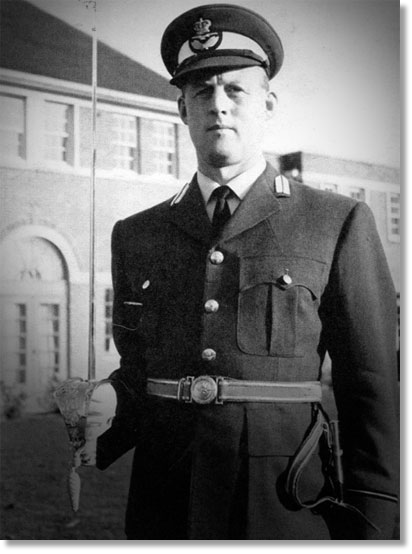
Marie has asked me to thank every single person that has come here today to celebrate Norrie’s life with us and she would really love as many people as possible to come back to the Harbour Bistro to share a few tales - you all know how Norrie loved to socialize and be the life and soul of the party.
He would have loved to stand at the bar of the Running Horse, in the Royal Air Force Club in Piccadilly and retell the story of his final flight to Malta. I have it on good authority that others intend to stand and do just that with a glass of single malt, as one of his Air Movements Pals, Ian Envis, wrote, "May Norrie take his special place in the departure lounge of the Royal Air Force Movers, and rest in peace."
Norrie was, in the words of so many of his Royal Air Force colleagues, a legend. I think this was written in almost every message we have had from his beloved UKMAMS Old Bods.
Depending on where and when you met him; Norman, Nor, Sir, Mr Radcliffe, Flt Lt Radcliffe, Uncle Norman, Uncle Nor, Godfather Norrie, Daddy, Gran-Gran, Grandad - whatever name you remember him by, Norrie was a legend.
I love that my Dad was stabbed whilst in the Far East, that he was an extra in the film Bridge on the River Kwai and watching the film was a family ritual, we all knew exactly where to spot him. He could catch an octopus and dive for pearls. I loved that he would pull his own teeth out rather than bother with the dentist When he fell and smashed his shoulder and collar bone at the reservoir he drove home, gutted the trout, left Marie a note and drove himself up to the hospital. I love that he told his mother, Alice, the same joke every morning for years and always gave our mum Marie the daily prize for having the tidiest poached egg.
Norrie was loud, larger than life, mischievous, funny, energetic, determined, a fount of all knowledge, volatile, forgiving, loving, incredibly generous, intolerant, a teacher, an epic friend, loyal, forceful, courageous, adventurous, colourful, extraordinary, lovable, popular and resourceful.
He would have loved to stand at the bar of the Running Horse, in the Royal Air Force Club in Piccadilly and retell the story of his final flight to Malta. I have it on good authority that others intend to stand and do just that with a glass of single malt, as one of his Air Movements Pals, Ian Envis, wrote, "May Norrie take his special place in the departure lounge of the Royal Air Force Movers, and rest in peace."
Norrie was, in the words of so many of his Royal Air Force colleagues, a legend. I think this was written in almost every message we have had from his beloved UKMAMS Old Bods.
Depending on where and when you met him; Norman, Nor, Sir, Mr Radcliffe, Flt Lt Radcliffe, Uncle Norman, Uncle Nor, Godfather Norrie, Daddy, Gran-Gran, Grandad - whatever name you remember him by, Norrie was a legend.
I love that my Dad was stabbed whilst in the Far East, that he was an extra in the film Bridge on the River Kwai and watching the film was a family ritual, we all knew exactly where to spot him. He could catch an octopus and dive for pearls. I loved that he would pull his own teeth out rather than bother with the dentist When he fell and smashed his shoulder and collar bone at the reservoir he drove home, gutted the trout, left Marie a note and drove himself up to the hospital. I love that he told his mother, Alice, the same joke every morning for years and always gave our mum Marie the daily prize for having the tidiest poached egg.
Norrie was loud, larger than life, mischievous, funny, energetic, determined, a fount of all knowledge, volatile, forgiving, loving, incredibly generous, intolerant, a teacher, an epic friend, loyal, forceful, courageous, adventurous, colourful, extraordinary, lovable, popular and resourceful.
He was so many things to so many people - I am sure that you can imagine that Chrissy and I had an adventurous childhood. He taught us to fish and run, climb trees, wrestle, jump into water from huge cliffs in Malta - Chrissy could teach the modern tombstoners a thing or two. He showed us how to create our own adventures. There was no time for boredom. In between rock climbing, swimming, cricket and hide-and-seek, life was one big family competition and Norrie usually won. Car journeys were not just going from A to B, they were for scoring points for the number of legs seen on a road sign, for competitions to make up songs about the towns we drove through - who can forget the classic “Run Rabat” or “Mellieha, I just met a girl called Mellieha”.
In our family beaches were not for lying on - they were for gathering wood for our fire, looking for fossils, marking out handball courts, seeing who could name the type of cloud, bird, fish, plant, we could identify aircraft by shape and noise; if you ever heard cries of “Civvie Andover” from Hespera Terrace you could guarantee it was followed by a rush outside to see if we were right - even the dog Arran would join in. One big adventure...
In our family beaches were not for lying on - they were for gathering wood for our fire, looking for fossils, marking out handball courts, seeing who could name the type of cloud, bird, fish, plant, we could identify aircraft by shape and noise; if you ever heard cries of “Civvie Andover” from Hespera Terrace you could guarantee it was followed by a rush outside to see if we were right - even the dog Arran would join in. One big adventure...
Norrie would be the first to admit that in his youth he could be a little hot-headed. By youth I really mean between the ages 1 to 82, but he was a man of great principal and whilst Mohammed Ali used to proclaim he was the greatest - Norrie knew he was - it just went without saying - the proof was in the pudding. I can’t recall a time when Norrie was proved wrong - certainly not one he ever admitted to! He was the original GOOGLE - he had the answer to every question I ever asked - or he knew where to find it. Chrissy and I grew up with the phonetic alphabet being used on a daily basis. Norrie always announced it was our bedtime with a loud command to Foxtrot Oscar! I know that if you spit in a crab’s face it closes it’s claws and then you can pick it up by the back legs without being nipped, I know how to remove a sheep tick, I know how to bump start a car on my own, how to move a three piece suite alone, never to end a sentence with a preposition, I know... that Norrie was a big man.
Norrie was so very proud of being Manx, he loved every aspect of island life both here and in Malta, he loved the geology, the history, the folklore and fables but mostly he loved people - especially his extended family. He seemed to gather people into our family, as we journeyed through life, who stayed adopted by us all. Norrie truly was a lifelong friend to so many. He was so proud of all those he loved, but not just for the big things, he loved for example that Craig has joined the Lifeboat Crew, he was as proud of Jo Brew’s jam making abilities as he had been when she made it to the horse of the year show. He loved to talk about his childhood, and how well his three sisters were doing, he loved his ritualised arguments with Auntie Norah; it gave him great joy!
As many of you are aware Norrie had been suffering with the effects of Parkinson's Disease in recent years and If anyone would like to make a donation to the Parkinson's Disease Society in Norrie’s memory I am sure it will help them to continue to support families like our own as they try to cope with the life changes that accompany this progressive disease. But Norrie refused to let his Parkinson’s Disease get the better of him. I remember the day he got his diagnosis confirmed, he rang me to say there was good and bad news. The bad news was he had Parkinsons the good news was he had been selected to represent the island at the Commonwealth Games - he had been chosen to be the right arm in the hokey-cokey team.
Norrie was so very proud of being Manx, he loved every aspect of island life both here and in Malta, he loved the geology, the history, the folklore and fables but mostly he loved people - especially his extended family. He seemed to gather people into our family, as we journeyed through life, who stayed adopted by us all. Norrie truly was a lifelong friend to so many. He was so proud of all those he loved, but not just for the big things, he loved for example that Craig has joined the Lifeboat Crew, he was as proud of Jo Brew’s jam making abilities as he had been when she made it to the horse of the year show. He loved to talk about his childhood, and how well his three sisters were doing, he loved his ritualised arguments with Auntie Norah; it gave him great joy!
As many of you are aware Norrie had been suffering with the effects of Parkinson's Disease in recent years and If anyone would like to make a donation to the Parkinson's Disease Society in Norrie’s memory I am sure it will help them to continue to support families like our own as they try to cope with the life changes that accompany this progressive disease. But Norrie refused to let his Parkinson’s Disease get the better of him. I remember the day he got his diagnosis confirmed, he rang me to say there was good and bad news. The bad news was he had Parkinsons the good news was he had been selected to represent the island at the Commonwealth Games - he had been chosen to be the right arm in the hokey-cokey team.
Norrie never failed to surprise us - just when you thought you knew him well enough for him to be predictable he upped and surprised you all over again. He was such an incongruous mixture - he loved all sports especially his beloved rugby, he loved the great outdoors, he loved nothing more that to wear as few clothes as possible, always as brown as a berry in the summertime, but was a stickler for dress codes! He loved poetry, Father Brian’s Sermons and classical music, photography and cooking. But mostly Norrie loved anything that moved him to laughter or tears. It should come as no surprise that looking at this internet history this week the last page he bookmarked was "RAF Bawdy Ballads and Ditties". Norrie had a really sweet tooth - a fact he always denied but in the pockets of every one of his coats and jackets Marie found a secret stash of sweets along with a printed joke just in case the occasion demanded.
I think what Norrie really wanted most in life was to be loved and to please - he truly got more pleasure in helping people or giving a gift of his time, knowledge or money than anyone else I know. His ritual bets with Ross and Jock on obscure features - like the colour of the referees shirt in International Rugby matches always made us smile. He loved to show how he was taking an interest in people’s lives - he always watched Preston North End and West Ham Football results so he could chat to Tim and Dave about how Nottingham Forrest were doing so much better in the Kiss Ball league.
When I called to take Mum and Dad to the airport on 3rd June we had a real trip down memory lane. Norrie was in a very reflective mood and by the time we got to Ronaldsway we had revisited his childhood, where the family used to go on picnics, how he first met Marie, and as we reached Douglas he was singing down by the Red Rose Café at which point his reminiscing then reached his wedding reception as we drove past the former Metropole Hotel. He started to talk about his family and closest friends, how very proud he was of all of us, especially of Ben and Archie. Norrie told us how proud he was of Ben’s incredible academic achievements and how delightful he thought Ben’s girlfriend Lucy was and how he thought secretly she could be “the one.” Looking at Archie was like looking in the mirror for Norrie and he told us how pleased he was that Archie was such great sportsman, but was also that he was really working hard at school too. He promised that when he came home from Malta he would gather us all together for a family meal - I just don’t think he had planned on so many of us going to the Harbour Bistro with him - Cheers Norrie - it’s been a heck of ride!
Jane Short
Ramsey, Isle of Man
22nd June, 2016
I think what Norrie really wanted most in life was to be loved and to please - he truly got more pleasure in helping people or giving a gift of his time, knowledge or money than anyone else I know. His ritual bets with Ross and Jock on obscure features - like the colour of the referees shirt in International Rugby matches always made us smile. He loved to show how he was taking an interest in people’s lives - he always watched Preston North End and West Ham Football results so he could chat to Tim and Dave about how Nottingham Forrest were doing so much better in the Kiss Ball league.
When I called to take Mum and Dad to the airport on 3rd June we had a real trip down memory lane. Norrie was in a very reflective mood and by the time we got to Ronaldsway we had revisited his childhood, where the family used to go on picnics, how he first met Marie, and as we reached Douglas he was singing down by the Red Rose Café at which point his reminiscing then reached his wedding reception as we drove past the former Metropole Hotel. He started to talk about his family and closest friends, how very proud he was of all of us, especially of Ben and Archie. Norrie told us how proud he was of Ben’s incredible academic achievements and how delightful he thought Ben’s girlfriend Lucy was and how he thought secretly she could be “the one.” Looking at Archie was like looking in the mirror for Norrie and he told us how pleased he was that Archie was such great sportsman, but was also that he was really working hard at school too. He promised that when he came home from Malta he would gather us all together for a family meal - I just don’t think he had planned on so many of us going to the Harbour Bistro with him - Cheers Norrie - it’s been a heck of ride!
Jane Short
Ramsey, Isle of Man
22nd June, 2016
This newsletter is dedicated
to the memory of
Norrie Radcliffe
to the memory of
Norrie Radcliffe
Tony Gale
ukmamsoba@gmail.com
ukmamsoba@gmail.com
Click on the arrow to see content







